The Transition from Unregulated to Regulated Fishing in Thailand
Abstract
1. Introduction
2. Materials and Methods
2.1. Data Description
2.1.1. Fisheries Statistics
- E-license system: number of licensed fishing vessels by gear and size of vessels;
- Fishing Info system (the electronic information system of port-in port-out of fishing vessel): vessel name and registration, fishing gear, issuance date, and time of departure-arrival at port;
- Thai Flagged Catch Certification System (Fishing Logbook and Landing Declaration Information): departure-arrival date, fishing gears, fishing areas, the total weight of catch, catch by species;
- Vessel Monitoring System (VMS): fishing grounds (latitude, longitude);
- Field survey data at fishing ports, fishing effort, and catch composition: collected and compiled by the Marine Fisheries Research and Development Division.
- Artisanal fisheries: The source of data was from field surveys that covered 22 coastal provinces of Thailand and conducted by provincial fisheries officers following the advice of statisticians from the DOF Fisheries Statistics Analysis and Research Group, which was the same as before 2015, but the total number of vessels (N) was based on the fleet survey in 2015. The provincial officers surveyed the number of vessels using certain types of fishing gear and the fishers who used fishing gears without vessels sampled 10% of vessels that used each type of fishing gear and collected monthly data at the district level. Catch composition and fishing effort data from the field survey at landing sites by Marine Fisheries Research and Development Division were used to calculate the catch composition and effort of fishing vessels. Production and fishing effort of each fishing gear were classified by the fishing area.
- Commercial fishing vessels less than 10 GT: Data were collected from field surveys that covered 22 coastal provinces of Thailand by provincial fisheries officers following the advice of statisticians from the DOF Fisheries Statistics Analysis and Research Group. Fishing vessels were sampled from 10% of the vessels with a license in each type of fishing gear. Catch composition and fishing effort from field survey data at fishing ports by Marine Fisheries Research and Development Division were used to calculate catch composition and effort of fishing vessels.
- Commercial fishing vessels 10 to <30 GT: Data were collected from the fishing logbook and Landing Declaration from the Thai Flagged Catch Certification System and Marine Fisheries Research and Development Division.
- Commercial fishing vessels ≥30 GT: Data were collected from all sources mentioned above.
2.1.2. Research Vessel Survey Data
2.2. Assessment of MSY by Fox Model
2.3. Allocation of Fishing Effort for the Total Allowable Catch (TAC)
- Allocate TAC to artisanal vessels based on the current catch, and the number of artisanal fishing vessels from the survey done in 2015.
- Calculate the average of CPUE (kg/day) based on the current catch by dividing the size of the fishing vessel to the class interval of 10 GT; size less than 10, 10–19.99, 20–29.99, 30–39.99,…, 190–199.99 GT.where CPUEAZ is the CPUE of gear A in class interval Z in kg/day, CatchAZ is the annual total catch of gear A in kg/year, Fishing effortAZ is the annual total fishing effort of gear A in class interval Z in the number of fishing days in a year.
- Allocate fishing effort to commercial fishing vessels using low-efficiency gears by fixing the number of fishing days (365 days minus the days before and after a fishing trip, annual holidays such as New Year, and the days for vessel maintenance). All fishing vessels get the same number of fishing days.where NAZ is the number of the fishing vessels using gear A in class interval Z, d is the number of fishing days in a year, and Estimated total catchAZ is the estimated annual total catch of gear A in class interval Z in kg/year.
- Calculate the estimated total catch of gear A by adding all class intervals of gear A.
- Calculate the TAC for commercial fishing vessels using low-efficiency gear by summation of the estimated total catch of all fishing vessels using low-efficiency gear.
- Calculate the TAC for commercial fishing vessels using high-efficiency gears.where TACCommercial high efficiency is the TAC for commercial fishing vessels using gear with high efficiency in kg/year, TACArtisonal is the TAC for artisanal fishing vessels in kg/year, TACCommercial low efficiency is the TAC for commercial fishing vessels using gear with low efficiency in kg/year.
- Allocate fishing effort to commercial fishing vessels using high-efficiency gears, calculate the estimated fishing days of all gears assuming that all commercial fishing vessels using high-efficiency gears in the same species groups (demersal fishes, pelagic fishes, and anchovies) get the same number of fishing days by using the Equation (8).
- Calculate the total catch of all gears in each species group by adding the estimated total catch in all class intervals of all gears in the same species group and adjust the number of fishing days if the result is over or under TAC of commercial fishing vessels using high-efficiency gears in each species group.
3. Results
3.1. An Overview of the Open-Access Management Regime before 2015
3.2. An Overview of the Fisheries Management Process after 2015
- Demersal fish
- Pelagic fish
- Anchovies
- Demersal fish
- Pelagic fish
- Anchovies
Results of MSY Analysis and Setting TAC
3.3. Fishing Effort Allocation
3.3.1. Commercial Fishing License Issuance Process
3.3.2. Criteria for Allocating Commercial Fishing Licenses
3.3.3. Issuance of Fishing Licenses
3.4. Measures for Regulating Fishing Effort
3.5. Fisheries Resources Status
3.5.1. CPUE as an Indicator
- Research vessels
- Commercial Vessels
3.5.2. Fishing Effort Reduction
4. Discussion
5. Conclusions
Author Contributions
Funding
Acknowledgments
Conflicts of Interest
References
- DOF. Fisheries Statistics of Thailand 2017; Fisheries Development and Strategy Division, Department of Fisheries, Ministry of Agriculture and Cooperatives; DOF: Bangkok, Thailand, 2019; pp. 1–92.
- DOF. Thailand National Plan of Action to Prevent, Deter and Eliminate Illegal, Unreported and Unregulated Fishing (Thailand NPOA-IUU 2015–2019); Department of Fisheries: Bangkok, Thailand, 2015.
- FAO. The State of World Fisheries and Aquaculture; FAO: Rome, Italy, 2012.
- FAO. Implementation of the International Plan of Action to Prevent, Deter and Eliminate Illegal, Unreported and Unregulated Fishing; FAO Technical Guidelines for Responsible Fisheries; FAO: Rome, Italy, 2002.
- Charles, A.T. Use Rights and Responsible Fisheries: Limiting Access and Harvesting through Rights-Based Management. In A Fishery Manager’s Guidebook. Management Measures and Their Application; Cochrane, K., Ed.; FAO Fisheries Tech. Paper #424; FAO: Rome, Italy, 2002. Available online: http://www.fao.org/3/y3427e/y3427e06.pdf (accessed on 5 November 2019).
- FAO. Oceans and the Seas; Sustainable Development Knowledge Platform. Available online: https://sustainabledevelopment.un.org/topics/oceanandseas (accessed on 17 April 2020).
- FAO. Sustainable Development Goal 14: Conserve and Sustainably Use the Oceans, Seas and Marine Resources for Sustainable Development. Available online: https://sustainabledevelopment.un.org/sdg14 (accessed on 17 April 2020).
- DOF. Marine Fisheries Management Plan of Thailand A National Policy for Marine Fisheries Management 2015–2019; Department of Fisheries, Ministry of Agriculture and Cooperative and Command Center of Combating Illegal Fishing: Bangkok, Thailand, 2015.
- Office of the Council of State. Royal Ordinance on Fisheries B.E.2015, Government of Thailand. 2015. Available online: http://www.ratchakitcha.soc.go.th/DATA/PDF/2560/A/067/1.PDF (accessed on 17 April 2020). (In Thai)
- Office of the Council of State. Royal Ordinance on Fisheries (No. 2) B.E.2017. Government of Thailand. 2017. Available online: https://www.fisheries.go.th/law/web2/images/PR2558/3-Royal-Ordinance-on-Fisheries-Amendment-No2.pdf (accessed on 17 April 2020).
- Kongprakhon, P. Conduct of Fisheries Statistics Manual for Users; Fisheries Development Policy and Strategy Division, Department of Fisheries, Ministry of Agriculture and Cooperatives: Bangkok, Thailand, 2018; p. 55. (In Thai)
- DOF. The Marine Fisheries Statistics 2014 Based on the Sample Survey; Fishery Statistics Analysis and Research Group, Fisheries Development Strategy and Policy Division, Department of Fisheries, Ministry of Agriculture and Cooperatives: Bangkok, Thailand, 2016; p. 157. (In Thai)
- DOF. Fishing Community Production Survey in 2010; Fishery Statistics Analysis and Research Group, Information Technology Center, Department of Fisheries, Ministry of Agriculture and Cooperatives: Bangkok, Thailand, 2012; p. 103. (In Thai)
- DOF. Thai Fishing Vessels Statistics 2016; Fisheries Development Policy and Strategy Division, Department of Fisheries, Ministry of Agriculture and Cooperatives: Bangkok, Thailand, 2017; p. 200. (In Thai)
- Dessane, S. The Study for Assessment of Catch and Fishing Effort of Trawl Fisheries by Data from Port in-Port out, Fishing Logbook and Composition; Fisheries Development Policy and Strategy Division, Department of Fisheries, Ministry of Agriculture and Cooperatives: Bangkok, Thailand, 2018; p. 160. (In Thai)
- Chuapan, K.; Sinanan, P.; Sanitmajjaro, W.; Hoimuk, S.; Augsornpaob, U.; Chimkaew, W. Marine Resources in the Gulf of Thailand and Andaman Sea from Research Vessel during 2003–2005; Department of Fisheries, Ministry of Agriculture and Cooperatives: Bangkok, Thailand, 2008; p. 132. (In Thai)
- Sanitmajjaro, W.; Cheuapun, K.; Sinanant, P.; Chimkaew, W.; Hoimuk, S.; Maila-iad, P. Comparisons of Catch per Unit Effort of Marine Resources from Research Vessels in the Gulf of Thailand; Marine Fisheries Research and Development Bureau, Department of Fisheries, Ministry of Agriculture and Cooperatives: Bangkok, Thailand, 2005; pp. 1–19.
- Die, D.J.; Caddy, J.F. Sustainable yield indicators from biomass: Are there appropriate reference points for use in tropical fisheries? Fish. Res. 1997, 32, 69–79. [Google Scholar] [CrossRef]
- Saikliang, P. Status of Sardine Resources and Fisheries in the Gulf of Thailand; Marine Fisheries Research and Development Bureau, Department of Fisheries, Ministry of Agriculture and Cooperatives: Bangkok, Thailand, 2003; pp. 1–57. (In Thai)
- Boonsuk, S.; Jaiyen, T.; Sumontha, M.; Nontapun, T. Stock Assessment of Round Scad Decapterus maruadsi (Temminck & Schlegel, 1843) along the Andaman Sea Coast of Thailand; Marine Fisheries Research and Development Bureau, Department of Fisheries, Ministry of Agriculture and Cooperatives: Bangkok, Thailand, 2010. (In Thai)
- Boonsuk, S.; Sumontha, M.; Sa-nga-ngam, C.; Tes-a-sen, K. Stock Assessment of Anchovies (Encrasicholina devisi (Whitley, 1940), E. punctifer Fowler, 1938 and E. heteroloba (Ruppell, 1837)) along the Andaman Sea Coast of Thailand; Marine Fisheries Research and Development Bureau, Department of Fisheries, Ministry of Agriculture and Cooperatives: Bangkok, Thailand, 2010.
- Hoimuk, S.; Krajangdara, T.; Sumontha, M.; Boonsuk, S.; Singtongyam, W. Stock Assessment of Delagoa Threadfin Bream, Nemipterus bipunctatus (Valenciennes, 1830) along the Andaman Sea Coast of Thailand; Marine Fisheries Research and Development Bureau, Department of Fisheries, Ministry of Agriculture and Cooperatives: Bangkok, Thailand, 2013.
- Hoimuk, S.; Sumontha, M.; Boonsuk, S.; Keereetut, P.; Singtongyam, W. Stock Assessment of Purple-spotted Bigeye (Priacanthus tayenus (Richardson, 1846)) along the Andaman Sea Coast of Thailand; Marine Fisheries Research and Development Bureau, Department of Fisheries, Ministry of Agriculture and Cooperatives: Bangkok, Thailand, 2013.
- Jaiyen, T.; Boonsuk, S.; Sumontha, M.; Signtongyam, W.; Nontapun, T. Stock Assessment of Yellowstripe Scad (Selaroides leptolepis (Cuvier, 1833)) along the Andaman Sea Coast of Thailand; Marine Fisheries Research and Development Bureau, Department of Fisheries, Ministry of Agriculture and Cooperatives: Bangkok, Thailand, 2011.
- Keereerut, P.; Sumontha, M.; Boonsuk, S.; Singtongyam, W.; Nontapan, T. Stock Assessment of Hardtail Scad, Megalaspis cordyla (Linnaeus, 1758) along the Andaman Sea Coast of Thailand; Marine Fisheries Research and Development Bureau, Department of Fisheries, Ministry of Agriculture and Cooperatives: Bangkok, Thailand, 2011.
- Panjarat, S.; Boonsuk, S.; Sumontha, M.; Hoimook, S.; Singtongyam, W. Stock Assessment of Lizardfishes, Saurida undosquamis (Richardson, 1848) and S. elongata (Temminck & Schlegel, 184)), along the Andaman Sea Coast of Thailand; Marine Fisheries Research and Development Bureau, Department of Fisheries, Ministry of Agriculture and Cooperatives: Bangkok, Thailand, 2012.
- Sonthaya, B.; Kongprom, A.; Hoimuk, S.; Sumongha, M.; Tes-a-sen, K. Stock Assessment of Squids, Photololigo chinensis Gray, 1849 and P. duvaucelii d’Orbigan, 1835 along the Andaman Sea Coast of Thailand; Marine Fisheries Research and Development Bureau, Department of Fisheries, Ministry of Agriculture and Cooperatives: Bangkok, Thailand, 2010.
- Sumontha, M.; Boonsuk, S.; Panjarat, S.; Jaiyen, T.; Ritthisaman, J. Stock Assessment of Indian Mackerel (Rastrelliger kanagurta (Cuvier, 1816)) along the Andaman Sea Coast of Thailand; Marine Fisheries Research and Development Bureau, Department of Fisheries, Ministry of Agriculture and Cooperatives: Bangkok, Thailand, 2010.
- Sumontha, M.; Boonsuk, S.; Keereerut, P. Stock Assessment of Bigeye Scad (Selar crumenophthalmus (Bloch, 1793)) along the Andaman Sea Coast of Thailand; Marine Fisheries Research and Development Bureau, Department of Fisheries, Ministry of Agriculture and Cooperatives: Bangkok, Thailand, 2012.
- Loychuen, K.; Hoimuk, S.; Boonsuk, S.; Ritthisaman, J. Stock Assessment of Sunrise Goatfish Upeneus sulphureus (Cuvier, 1829) along the Andaman Sea Coast of Thailand; Marine Fisheries Research and Development Bureau, Department of Fisheries, Ministry of Agriculture and Cooperatives: Bangkok, Thailand, 2010; pp. 1–41. (In Thai)
- Kongprom, A.; Chuapun, K.; Augsorpa-ob, U.; Sinanun, T.; Khongchai, N.; Phoonsawat, R. Stock Assessment of Purple-Spotted Bigeye (Priacanthus tayenus Ricahardson, 1846) in the Gulf of Thailand; Marine Fisheries Research and Development Bureau, Department of Fisheries, Ministry of Agriculture and Cooperatives: Bangkok, Thailand, 2010; pp. 1–42. (In Thai)
- Sinanun, P.; Pankaew, K.; Yamrungrueng, A.; Boonjorn, N.; Tossapornpitakkul, S. Stock Assessment of Torpedo Scad (Megalaspis cordyla (Linnaeus, 1758)) in the Gulf of Thailand in 2007; Marine Fisheries Research and Development Bureau, Department of Fisheries, Ministry of Agriculture and Cooperatives: Bangkok, Thailand, 2012.
- Sinanun, P.; Sinanun, T.; Chaimeesook, K.; Augsornpa-ob, U.; Kongprom, A. Stock Assessment of Saurida elongata (Temminck & Schlegel, 1846) and S. undosquamis (Richardson, 1848) in the Gulf of Thailand; Marine Fisheries Research and Development Bureau, Department of Fisheries, Ministry of Agriculture and Cooperatives: Bangkok, Thailand, 2012.
- Sinanun, T. Stock Assessment of Blue Swimming Crab (Portunus Pelagicus (Linnaeus, 1758)) in the Eastern Gulf of Thailand; Marine Fisheries Research and Development Bureau, Department of Fisheries, Ministry of Agriculture and Cooperatives: Bangkok, Thailand, 2012.
- Thongsila, K.; Sinanun, T.; Noranarttragoon, P.; Boonjorn, N.; Khemakorn, P. Stock Assessment of Indian Mackerel (Rastrelliger kanagurta (Cuvier, 1817)) in the Gulf of Thailand; Marine Fisheries Research and Development Bureau, Department of Fisheries, Ministry of Agriculture and Cooperatives: Bangkok, Thailand, 2012.
- Thongsila, K.S.; Sinanun, T. Stock Assessment of Banana Prawn (Penaeus merguiensis De Man, 1888) in the Eastern Gulf of Thailand; Marine Fisheries Research and Development Bureau, Department of Fisheries, Ministry of Agriculture and Cooperatives: Bangkok, Thailand, 2013.
- Petchkamned, J.K.; Yamrungrueng, A.; Sin-a-nun, T. Stock Assessment of Anchovy in the Gulf of Thailand; Marine Fisheries Research and Development Bureau, Department of Fisheries, Ministry of Agriculture and Cooperatives: Bangkok, Thailand, 2014.
- Janekitkosol, W.; Somchanakij, H.; Eiamsa-ard, M.; Supongpan, M. Strategic review of the fishery situation in Thailand. In Assessment, Management and Future Directions for Coastal Fisheries in Asia Countries, Malaysia; Silvestre, G.G., Garces, L., Stobutzki, I., Ahmed, M., Valmonte-Santos, R.A., Luna, C., Lachica-Alino, L., Munro, P., Christensen, V., Pauly, D., Eds.; Worldfish Center Malaysia: Penang, Malaysia, 2003; pp. 915–955. [Google Scholar]
- Royal Thai Government Gazette. Fisheries Announcement. In Rule No. 135, Section No. 29D; Cabinet and Royal Gazette Publishing Office: Bangkok, Thailand, 2018; pp. 14–16.
- Morgan, A.C.; Burgess, G.H. Fishery-Dependent Sampling: Total Catch, Effort and Catch Composition. In Management Techniques for Elasmobranch Fisheries; Musick, J.A., Bonfil, R., Eds.; FAO Fisheries Technical Paper; FAO: Rome, Italy, 2005; pp. 182–200. [Google Scholar]
- Gulland, J.A. Manual of Methods for Fish Stock Assessment, Part 1, Fish Population Analysis; Fish Stock Evaluation Branch Fishery Resources and Exploitation Division; FAO: Rome, Italy, 1969; pp. 1–154.
- Sparre, P.; Venema, S.C. Introduction to Tropical Fish Stock Assessment. Part 1. Manual; FAO Fisheries Technical Paper. No. 306.1, REV. 2; FAO: Rome, Italy, 1998.
- Drammeh, O.K.L. Illegal, Unreported and Unregulated Fishing in Small-Scale Marine and Inland Capture Fishieries. FAO Report. Available online: http://www.fao.org/3/Y3274E/y3274e09.htm (accessed on 29 March 2020).
- Erceg, D. Deterring IUU fishing through state control over nationals. Mar. Policy 2006, 30, 173–179. [Google Scholar] [CrossRef]
- Halls, A.S.; Welcomme, R.L.; Burn, R.W. The relationship between multi-species catch and effort: Among fishery comparisons. Fish. Res. 2006, 77, 78–83. [Google Scholar] [CrossRef]
- Squires, D.; Maunder, M.; Vestergaard, N.; Restrepo, V.; Metzner, R.; Herrick, S., Jr.; Hannesson, R.; Del Valle, I. Effort rights in fisheries management: General principles and case studies from around the world. In Effort Rights in Fisheries Management: General Principles and Case Studies from Around the World, 17–20 September 2012, Bilbao, Spain; Squires, D., Maunder, M., Vestergaard, N., Restrepo, V., Metzner, R., Herrick, S., Hannesson, R., del Valle, I., Andersen, P., Eds.; FAO: Rome, Itlay, 2014; pp. 1–9. [Google Scholar]
- Squires, D.; Maunder, M. Synthesis of workshop results: Pros and cons of effort based management. In Effort Rights in Fisheries Management: General Principles and Case Studies from Around the World, 17–20 September 2012, Bilbao, Spain; Squires, D., Maunder, M., Vestergaard, N., Restrepo, V., Metzner, R., Herrick, S., Hannesson, R., del Valle, I., Andersen, P., Eds.; FAO: Rome, Italy, 2014; pp. 11–27. [Google Scholar]
- Squires, D.; Maunder, M.; Herrick, S., Jr.; Helvey, M.; Clarke, R. Effort rights-based management. In Effort Rights in Fisheries Management: General Principles and Case Studies from Around the World, 17–20 September 2012, Bilbao, Spain; Squires, D., Maunder, M., Vestergaard, N., Restrepo, V., Metzner, R., Herrick, S., Hannesson, R., del Valle, I., Andersen, P., Eds.; FAO: Rome, Italy, 2014; pp. 37–77. [Google Scholar]
- Cotter, J. Reforming the European Common Fisheries Policy: A case for capacity and effort controls. Fish Fish. 2010, 11, 210–219. [Google Scholar] [CrossRef]
- Bellido, J.M.; Sumaila, U.R.; Sánchez-Lizaso, J.L.; Palomares, M.L.; Pauly, D. Input versus output controls as instruments for fisheries management with a focus on Mediterranean fisheries. Mar. Policy 2020, 118, 103786. [Google Scholar] [CrossRef]
- Hoydal, K. Management of demersal fisheries in the Faroese Fishing Zone, FFT. In Effort Rights in Fisheries Management: General Principles and Case Studies from Around the World, 17–20 September 2012, Bilbao, Spain; Squires, D., Maunder, M., Vestergaard, N., Restrepo, V., Metzner, R., Herrick, S., Hannesson, R., del Valle, I., Andersen, P., Eds.; FAO: Rome, Italy, 2014; pp. 181–197. [Google Scholar]
- Hannesson, R. Effort versus quota control when stocks cannot be targeted. In Effort Rights in Fisheries Management: General Principles and Case Studies from Around the World, 17–20 September 2012, Bilbao, Spain; Squires, D., Maunder, M., Vestergaard, N., Restrepo, V., Metzner, R., Herrick, S., Hannesson, R., del Valle, I., Andersen, P., Eds.; FAO: Rome, Italy, 2014; pp. 87–97. [Google Scholar]
- Ellefson, H. The transferable effort system in the Faroe Islands. In Effort Rights in Fisheries Management: General Principles and Case Studies from Around the World, 17–20 September 2012, Bilbao, Spain; Squires, D., Maunder, M., Vestergaard, N., Restrepo, V., Metzner, R., Herrick, S., Hannesson, R., del Valle, I., Andersen, P., Eds.; FAO: Rome, Italy, 2014; pp. 151–162. [Google Scholar]
- Rijnsdorp, A.D.; Daan, N.; Dekker, W.; Poos, J.J.; Van Densen, W.L.T. Sustainable use of flatfish resources: Addressing the credibility crisis in mixed fisheries management. J. Sea Res. 2007, 57, 114–125. [Google Scholar] [CrossRef]
- Rätz, H.-J.; Lloret, J. Inter-species quota flexibility—Exploring a new management tool in European Common Fisheries Policy. Ocean Coast. Manag. 2018, 163, 222–231. [Google Scholar] [CrossRef]
- Baudron, A.; Ulrich, C.; Nielsen, J.; Boje, J. Comparative evaluation of a mixed-fisheries effort-management system based on the Faroe Islands example. ICES J. Mar. Sci. 2010, 67, 1036–1050. [Google Scholar] [CrossRef]
- García-Carreras, B.; Dolder, P.; Engelhard, G.H.; Lynam, C.P.; Bayliss-Brown, G.A.; Mackinson, S. Recent experience with effort management in Europe: Implications for mixed fisheries. Fish. Res. 2015, 169, 52–59. [Google Scholar] [CrossRef]
- Hannesson, R. Is there a case for effort control? In Effort Rights in Fisheries Management: General Principles and Case Studies from Around the World, 17–20 September 2012, Bilbao, Spain; Squires, D., Maunder, M., Vestergaard, N., Restrepo, V., Metzner, R., Herrick, S., Hannesson, R., del Valle, I., Andersen, P., Eds.; FAO: Rome, Italy, 2014; pp. 79–85. [Google Scholar]
- Clarke, R.; Dalzell, P.; Ikehara, W. Hawaii pelagic longline fishery and sea turtle bycatch—The use of set certificates as an allocation solution. In Effort Rights in Fisheries Management: General Principles and Case Studies from Around the World, 17–20 September 2012, Bilbao, Spain; Squires, D., Maunder, M., Vestergaard, N., Restrepo, V., Metzner, R., Herrick, S., Hannesson, R., del Valle, I., Andersen, P., Eds.; FAO: Rome, Italy, 2014; pp. 135–149. [Google Scholar]
- Thunberg, E.; Lee, M.Y. The effort control programme in the northeast United States groundfish fishery. In Effort Rights in Fisheries Management: General Principles and Case Studies from Around the World, 17–20 September 2012, Bilbao, Spain; Squires, D., Maunder, M., Vestergaard, N., Restrepo, V., Metzner, R., Herrick, S., Hannesson, R., del Valle, I., Andersen, P., Eds.; FAO: Rome, Italy, 2014; pp. 215–234. [Google Scholar]
- Mulazzani, L.; Camanzi, L.; Bonezzi, A.; Malorgio, G. Individual transferable effort quotas for Italian fisheries? A preliminary analysis. Mar. Policy 2018, 91, 14–21. [Google Scholar] [CrossRef]
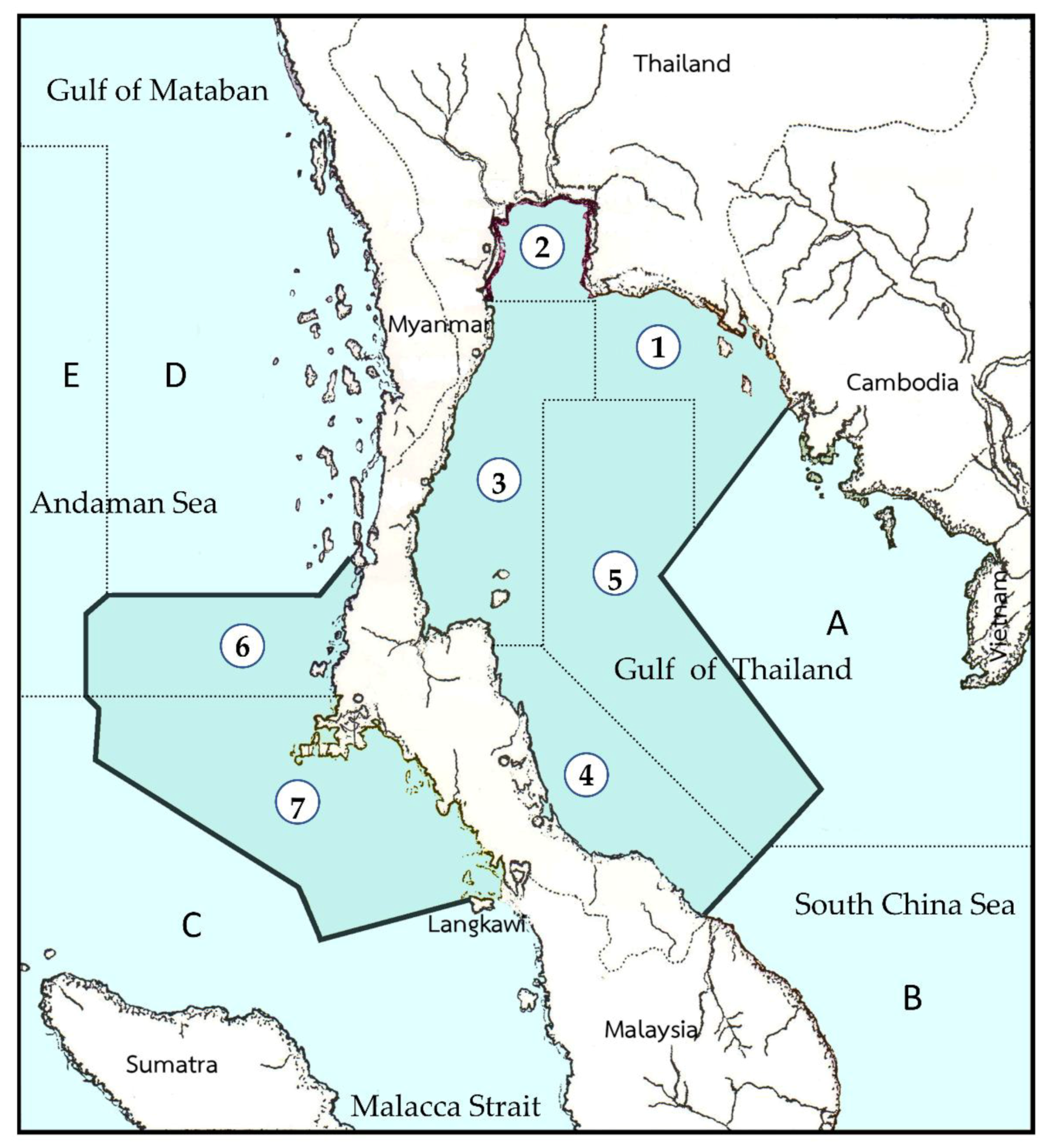
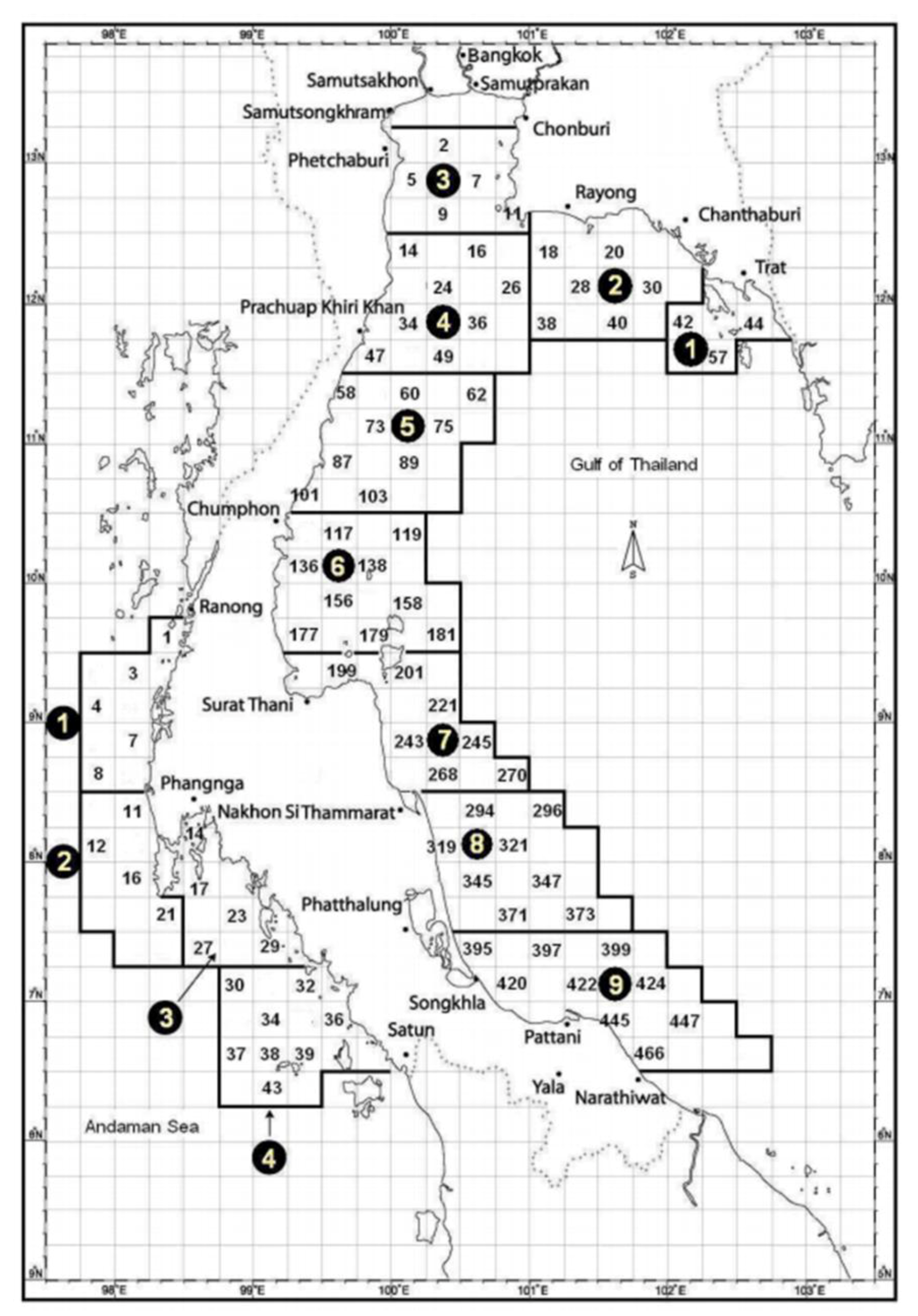

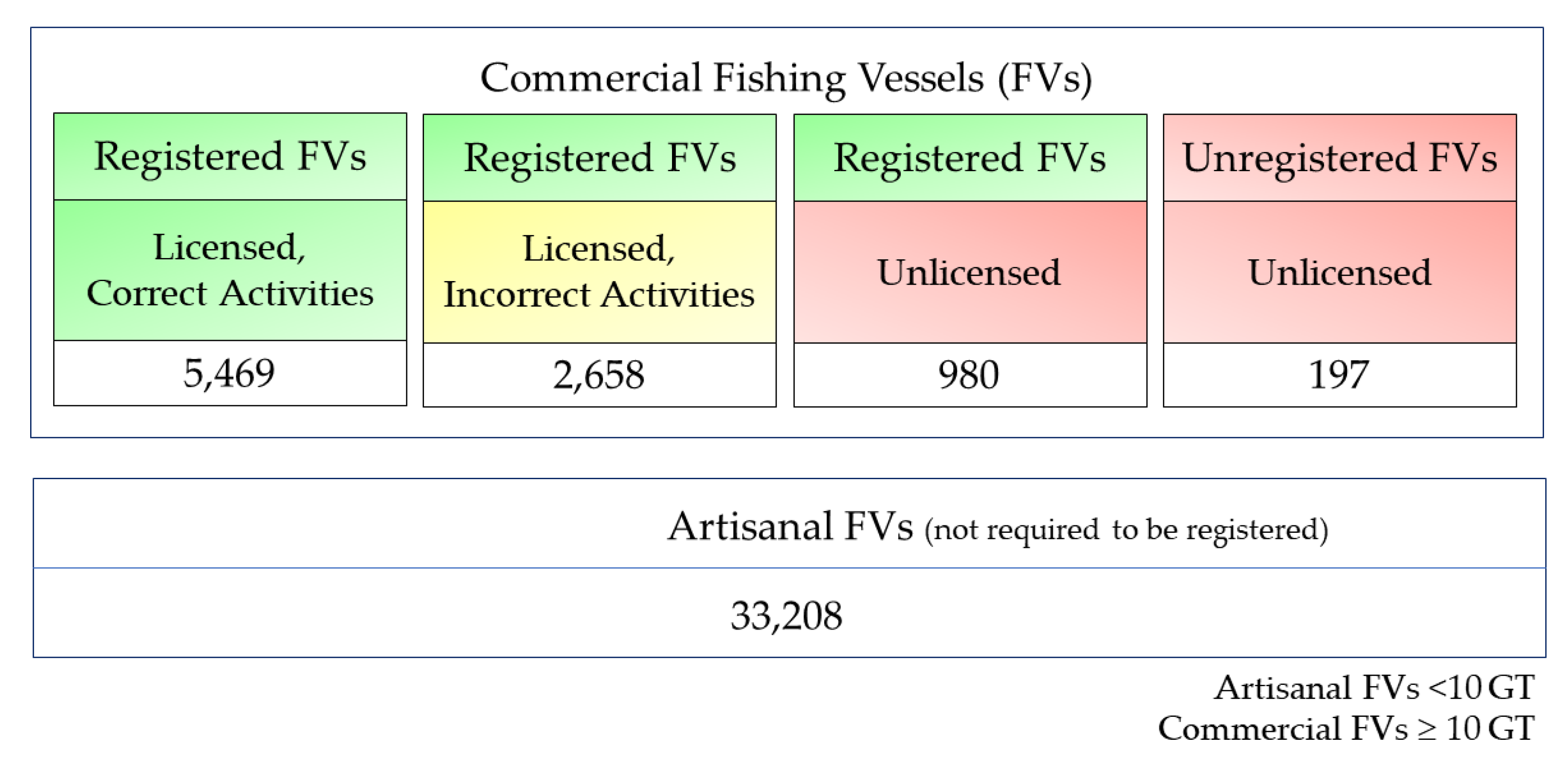
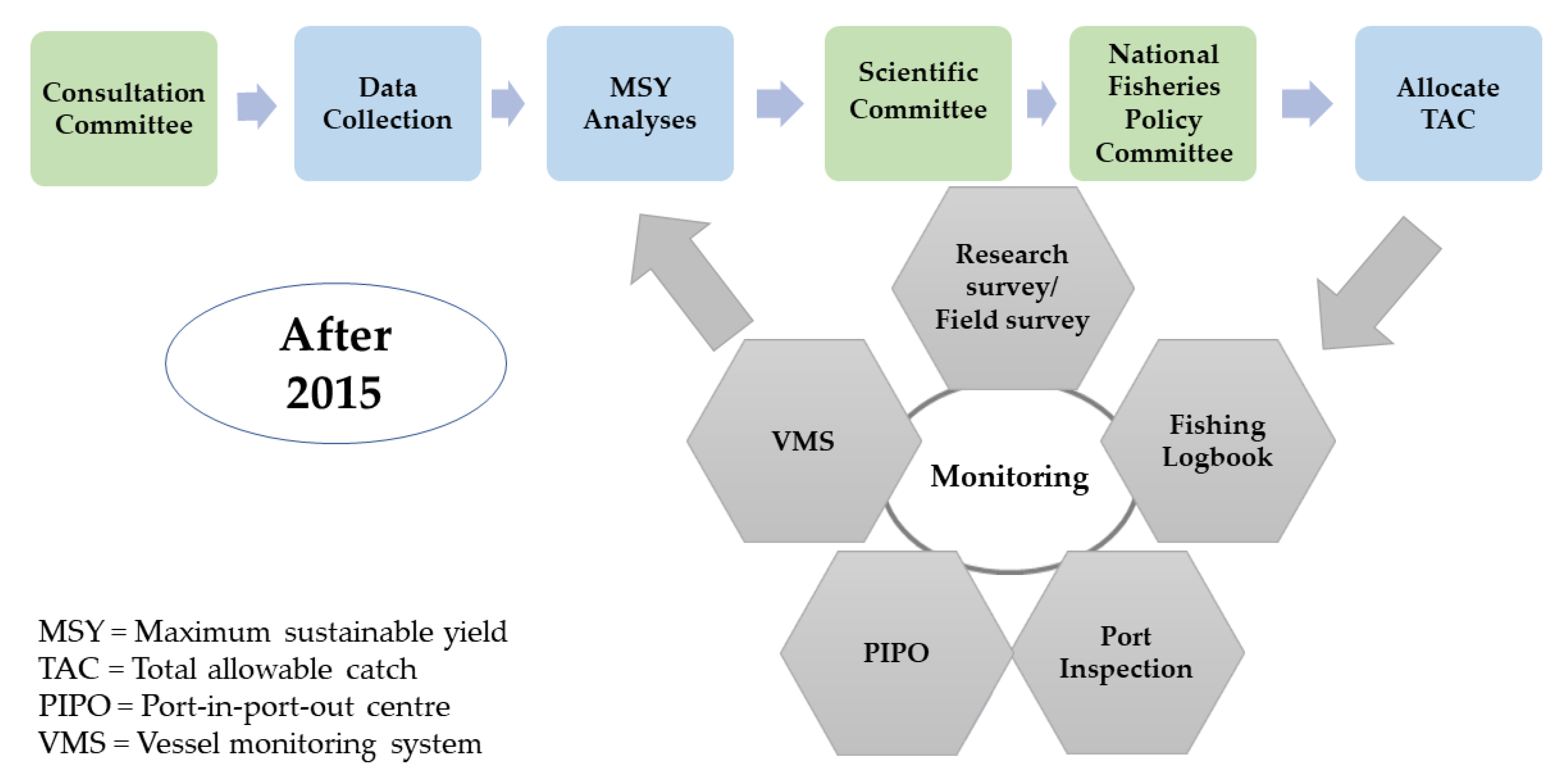
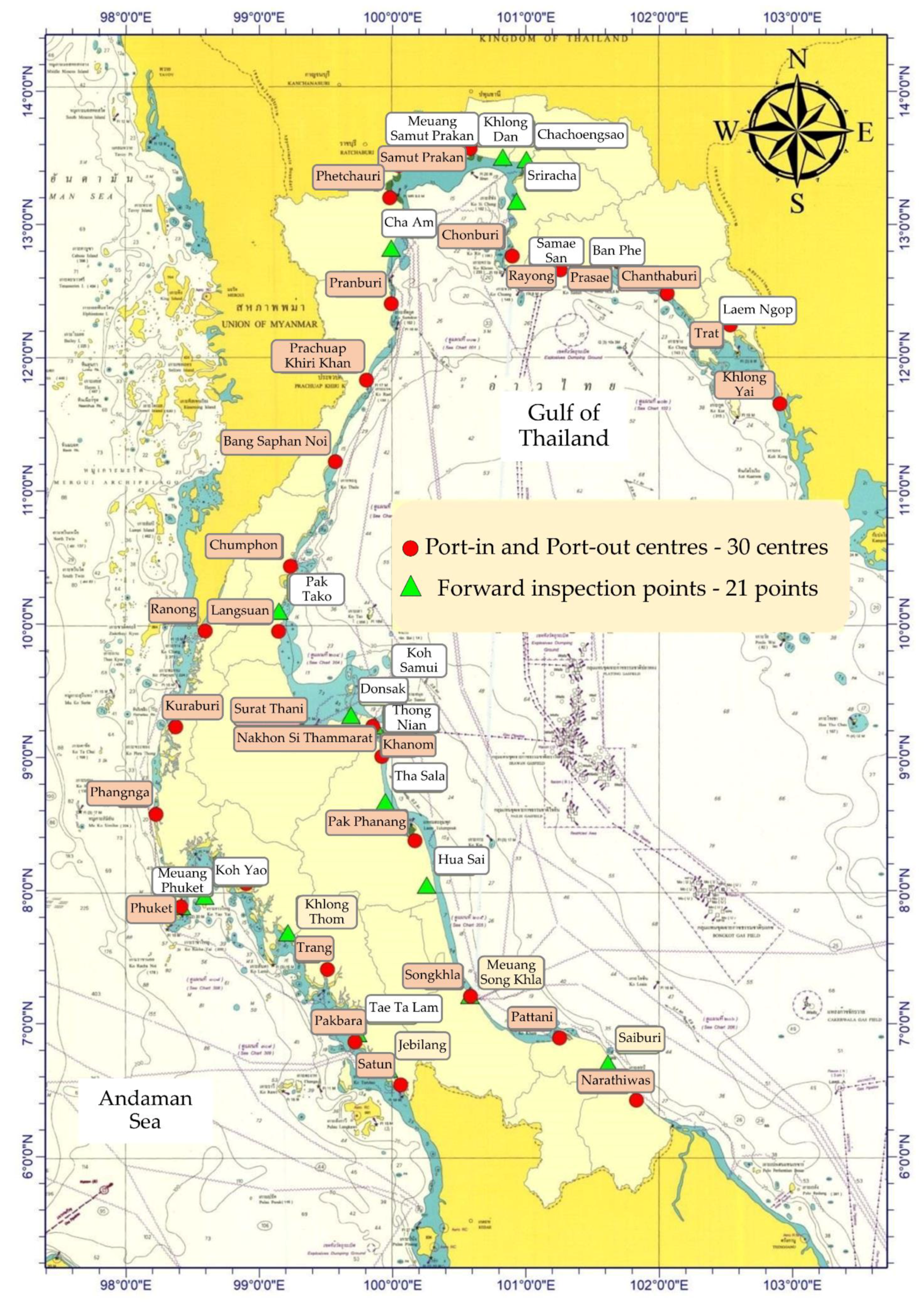
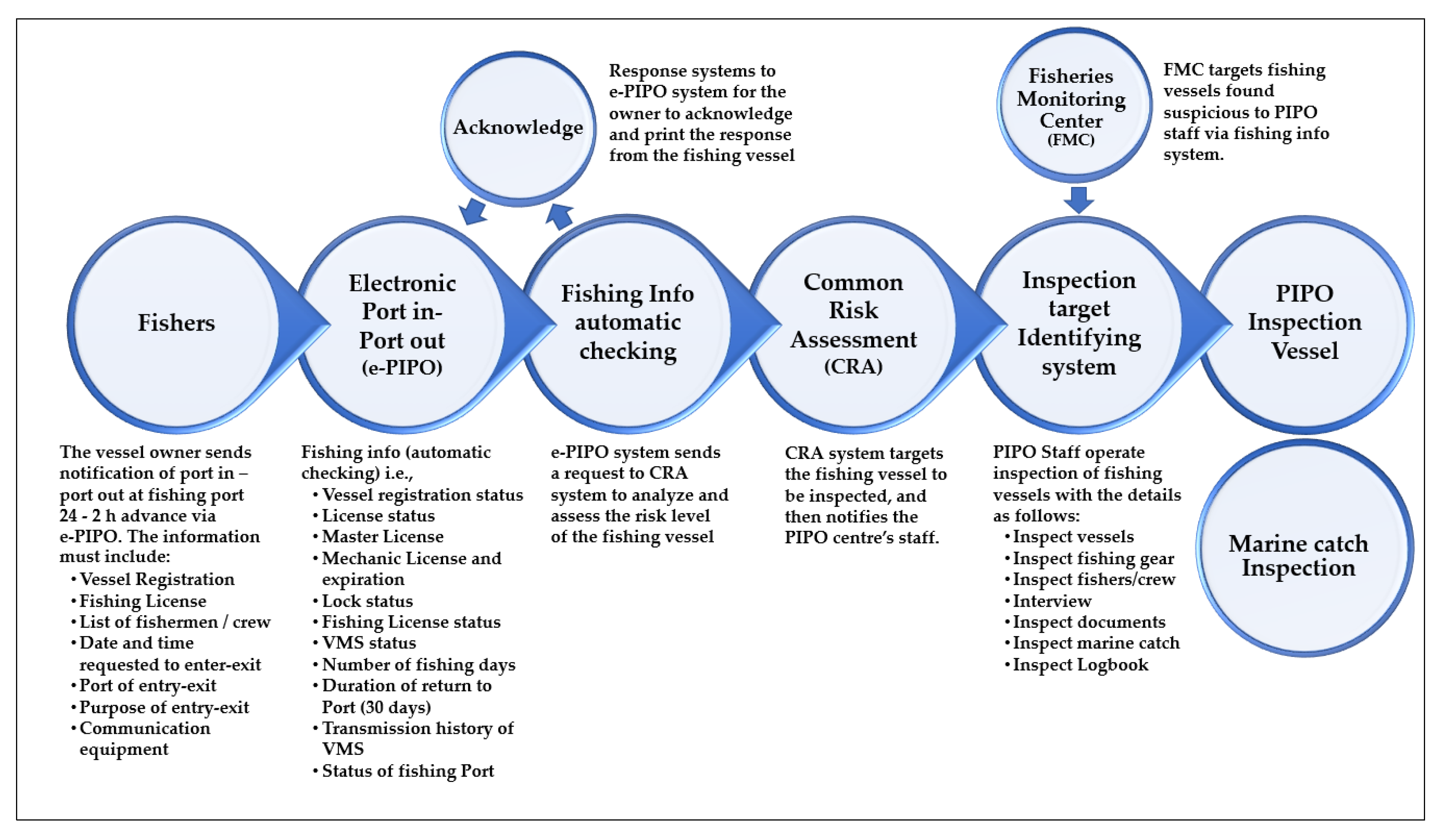

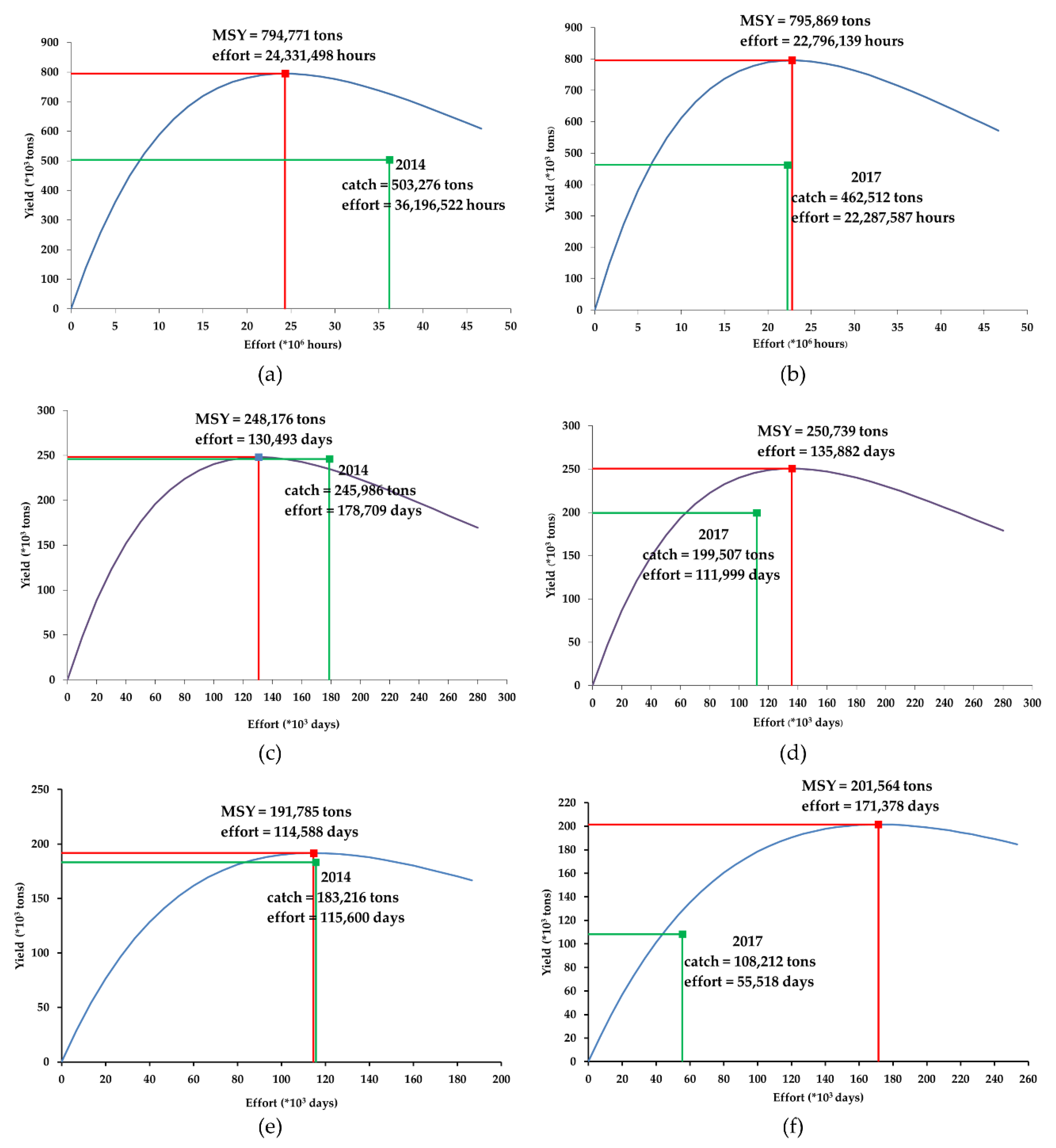
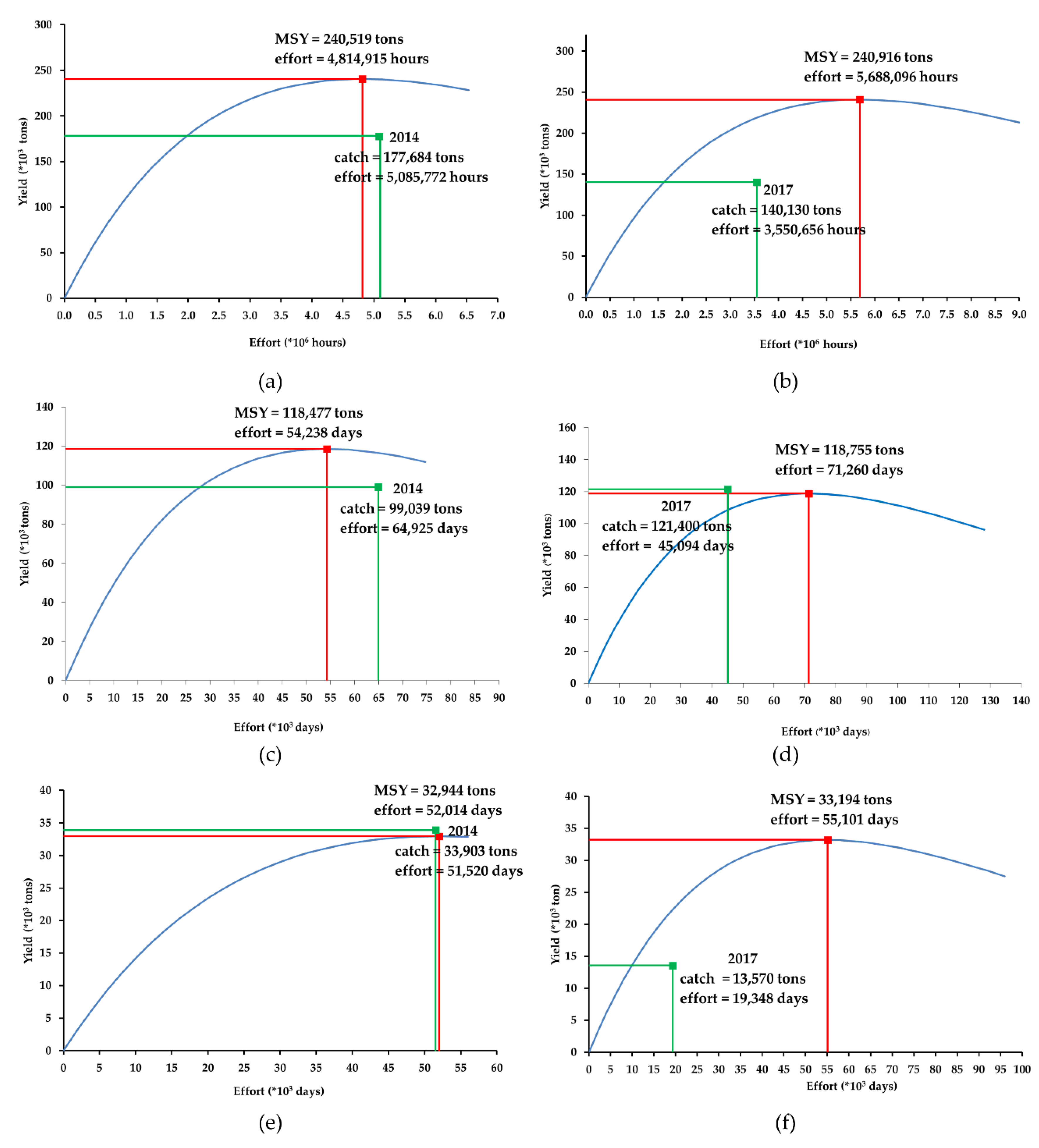
| Area | Station Number | |
|---|---|---|
| Gulf of Thailand | Area 1 | 42, 44, 57 |
| Area 2 | 18, 20, 28, 30, 38, 40 | |
| Area 3 | 2, 5, 7, 9, 11 | |
| Area 4 | 14, 16, 24, 26, 34, 36, 47, 49 | |
| Area 5 | 58, 60, 62, 73, 75, 87, 89, 101, 103 | |
| Area 6 | 117, 119, 136, 138, 156, 158, 177, 179, 181 | |
| Area 7 | 201, 221, 243, 245, 268, 270 | |
| Area 8 | 294, 296, 319, 321, 345, 347, 371, 373 | |
| Area 9 | 395, 397, 399, 420, 422, 424, 445, 447, 466 | |
| Andaman Sea | Area 1 | 1, 3, 4, 7, 8 |
| Area 2 | 11, 12, 16, 21 | |
| Area 3 | 14, 17, 23, 27, 29 | |
| Area 4 | 30, 32, 34, 36, 37, 38, 39, 43 |
| Fishing Areas/Resource Groups | MSY (Tons) | Optimal Fishing Effort | in 2017 | Status of Fisheries | ||
|---|---|---|---|---|---|---|
| Catch (Tons) | Fishing Effort | Exceeded/Balanced/Lower | Percentage | |||
| Gulf of Thailand | ||||||
| 795,869 | 22.80 mh 1 | 462,512 | 22.29 mh | 0.51 mh | −2.28% |
| 250,739 | 135,882 days | 199,507 | 111,999 days | 23,883 days | −21.32% |
| 201,564 | 171,378 days | 108,212 | 55,518 days | 115,860 days | −208.69% |
| Andaman Sea | ||||||
| 240,916 | 5.69 mh | 140,130 | 3.55 mh | 2.14 mh | −60.20% |
| 118,755 | 71,260 days | 121,400 | 45,094 days | 26,166 days | −58.03% |
| 33,194 | 55,101 days | 13,570 | 19,348 days | 35,753 days | −184.79% |
| Grand total | 1,641,037 | - | 1,045,331 | - | - | - |
| Fishing Areas/Resource Groups | MSY (Tons) | Total Allowable Catch (Tons) | Standard Fishing Effort at MSY | Standard Fishing Effort at Total Allowable Catch (TAC) | Catch Per Unit of Effort (CPUE) of Standard Gear at TAC |
|---|---|---|---|---|---|
| Gulf of Thailand | |||||
| 795,869 | 756,076 | 22,796,139 h | 16,252,550 h | 46.52 kg/h |
| 250,739 | 238,202 | 135,882 days | 96,877 days | 2458.81 kg/day |
| 201,564 | 191,486 | 171,378 days | 122,185 days | 1567.18 kg/day |
| Sub-total | 1,248,172 | 1,185,763 | - | - | - |
| Andaman Sea | |||||
| 240,916 | 228,870 | 5,688,096 h | 4,055,350 h | 56.44 kg/h |
| 118,755 | 112,817 | 71,260 days | 50,805 days | 2220.59 kg/day |
| 33,194 | 31,534 | 55,101 days | 39,285 days | 802.70 kg/day |
| Sub-total | 392,865 | 373,221 | - | - | - |
| Grand total | 1,641,037 | 1,558,984 | - | - | - |
| Activity | Period | |
|---|---|---|
| 1. | Application for the fishing license | 20 January to 20 February 2018 |
| 2. | Vessel inspection for renewing of vessel permit | 20 January to 28 February 2018 |
| 3. | Consideration and allocation of fishing licenses by the Consideration and Allocation Committee | 1–15 March 2018 |
| 4. | Receive of fishing licenses (Pay for the license fee/Receive fishing license/Receive appointment document of fishing gear inspection) | 16–30 March 2018 |
| 5. | Fishing gear inspection follows the Thai Department of Fisheries (DOF) fishing gear inspection procedure | From 17 March 2018, onward |
| High-Efficiency Fishing Gear | Low-Efficiency Fishing Gear |
|---|---|
| 1. Pair trawl | 9. Squid falling net |
| 2. Otter board trawl | 10. Pomfret lift net |
| 3. Beam trawl | 11. Gillnet |
| 4. Purse seine | 12. Krill push net |
| 5. Anchovy purse seine | 13. Baby clam dredge |
| 6. Anchovy falling net | 14. Blood clam dredge |
| 7. Anchovy lift net | 15. Other shell dredges |
| 8. Light luring vessel | 16. Fish trap |
| 17. Crab trap | |
| 18. Squid trap | |
| 19. Octopus trap | |
| 20. Longline | |
| 21. Red frog crab lift net | |
| 22. Handline |
| TAE in 2018 | Allocated Standard Fishing Effort | Balance ofStandard Effort | TAC in 2018 | Allocated Catch (Tons) | Balance (Tons) | |
|---|---|---|---|---|---|---|
| Gulf of Thailand | ||||||
| Total | 1,185,764 | 1,096,053 | 89,711 | |||
| 1. Demersal | 16,252,550 h | 15,552,363 h | 700,187 h | 756,076 | 723,503 | 32,573 |
| 2. Pelagic | 96,877 days | 85,910 days | 10,967 days | 238,202 | 211,237 | 26,965 |
| 3. Anchovy | 122,185 days | 102,932 days | 19,253 days | 191,486 | 161,313 | 30,173 |
| Andaman Sea | ||||||
| Total | 373,221 | 341,570 | 31,651 | |||
| 1. Demersal | 4,055,335 h | 3,684,832 h | 370,503 h | 228,870 | 207,960 | 20,910 |
| 2. Pelagic | 50,805 days | 48,030 days | 2775 days | 112,817 | 106,655 | 6162 |
| 3. Anchovy | 39,285 days | 33,581 days | 5704 days | 31,534 | 26,955 | 4579 |
| Fishing License (Gulf of Thailand; GoT) | |||||||
|---|---|---|---|---|---|---|---|
| S (10–29.99 GT) | M (20–59.99 GT) | L (60–149.99 GT) | X (≥150 GT) | Total | Estimated Total Standard Effort | Estimated Catch | |
| Total artisanal vessels in GoT | 18,391 | 100,618 | |||||
| Total artisanal vessels with high-efficiency gear in GoT | 542 | 53,999 | |||||
| Total commercial vessels in GoT | 1408 | 3888 | 1962 | 65 | 8574 | 941,436 | |
| 1. Demersal | |||||||
| Total artisanal vessels | 17,269 | 2,015,543 | 93,764 | ||||
| Total artisanal vessels with high-efficiency gear | 413 | 947,153 | 44,062 | ||||
| Total commercial vessels | 1163 | 3031 | 1225 | 13 | 5432 | 12,589,670 | 585,677 |
| 2. Pelagic | |||||||
| Total artisanal vessels | 1122 | 2788 | 6854 | ||||
| Total artisanal vessels with high-efficiency gear | 104 | 2698 | 6635 | ||||
| Total commercial vessels | 172 | 482 | 557 | 34 | 1245 | 79,743 | 197,748 |
| 3. Anchovy | |||||||
| Total artisanal vessels | - | - | |||||
| Total artisanal vessels with high-efficiency gear | 25 | 2107 | 3302 | ||||
| Total commercial vessels | 73 | 375 | 180 | 18 | 646 | 100,825 | 158,011 |
| Fishing License (Andaman Sea; AS) | |||||||
|---|---|---|---|---|---|---|---|
| S (10–29.99 GT) | M (20–59.99 GT) | L (60–149.99 GT) | X (≥150 GT) | Total | Estimated Total Standard Effort | Estimated Catch | |
| Total artisanal vessels in AS | 7278 | 50,688 | |||||
| Total artisanal vessels with high-efficiency gear in AS | 64 | 14,360 | |||||
| Total commercial vessels in AS | 185 | 558 | 513 | 30 | 1315 | 0 | 296,269 |
| 1. Demersal | |||||||
| Total artisanal vessels | 6737 | 817,623 | 46,144 | ||||
| Total Artisanal vessels with high-efficiency gear | 39 | 90,703 | 5119 | ||||
| Total Commercial vessels | 147 | 381 | 339 | 10 | 877 | 2,776,522 | 156,698 |
| 2. Pelagic | |||||||
| Total Artisanal vessels | 541 | 2046 | 4544 | ||||
| Total Artisanal vessels with high-efficiency gear | 25 | 4161 | 9241 | ||||
| Total commercial vessels | 15 | 77 | 151 | 20 | 263 | 41,822 | 92,870 |
| 3. Anchovy | |||||||
| Total artisanal vessels | - | - | |||||
| Total artisanal vessels with high-efficiency gear | - | - | |||||
| Total commercial vessels | 32 | 115 | 28 | 175 | 33,580 | 26,955 | |
© 2020 by the authors. Licensee MDPI, Basel, Switzerland. This article is an open access article distributed under the terms and conditions of the Creative Commons Attribution (CC BY) license (http://creativecommons.org/licenses/by/4.0/).
Share and Cite
Kulanujaree, N.; Salin, K.R.; Noranarttragoon, P.; Yakupitiyage, A. The Transition from Unregulated to Regulated Fishing in Thailand. Sustainability 2020, 12, 5841. https://doi.org/10.3390/su12145841
Kulanujaree N, Salin KR, Noranarttragoon P, Yakupitiyage A. The Transition from Unregulated to Regulated Fishing in Thailand. Sustainability. 2020; 12(14):5841. https://doi.org/10.3390/su12145841
Chicago/Turabian StyleKulanujaree, Nipa, Krishna R Salin, Pavarot Noranarttragoon, and Amararatne Yakupitiyage. 2020. "The Transition from Unregulated to Regulated Fishing in Thailand" Sustainability 12, no. 14: 5841. https://doi.org/10.3390/su12145841
APA StyleKulanujaree, N., Salin, K. R., Noranarttragoon, P., & Yakupitiyage, A. (2020). The Transition from Unregulated to Regulated Fishing in Thailand. Sustainability, 12(14), 5841. https://doi.org/10.3390/su12145841






